Servicios Personalizados
Revista
Articulo
Indicadores
-
 Citado por SciELO
Citado por SciELO
Links relacionados
-
 Similares en
SciELO
Similares en
SciELO
Compartir
Revista de Ciencia y Tecnología
versión On-line ISSN 1851-7587
Rev. cienc. tecnol. no.31 Posadas jun. 2019
Ingeniería, Tecnología e Informática
Densidad del puré de mandioca rehidratada en función de la concentración y la temperatura
Density of Rehydrated Mashed Cassava as a Function of Concentration and Temperature
María M. Brousse1*,Ramón A. Linares1
1- Faculty of Exact, Chemistry and Life Sciences, National University of Misiones. Posadas, Argentina. . * E-mail: brousse.mariamarcela@gmail.com
Resumen
El puré de mandioca deshidratada es un nuevo alimento en el mundo desarrollado por nuestro grupo de investigación. La densidad del puré de mandioca rehidratada para las variedades Concepción y Pomberí se determinó en un rango de concentración de 125 a 200 g/L y temperaturas entre 30 y 80º C. Los valores de densidad aumentan cuando la concentración aumenta y la temperatura disminuye. Los valores de densidad de ambas variedades se ajustaron a una ecuación de regresión múltiple en función de la temperatura y la concentración, con un nivel de confianza del 95%. El efecto de la concentración sobre la densidad puede describirse mediante ecuaciones lineales, potenciales y exponenciales, y todas las ecuaciones fueron estadísticamente significativas con un nivel de confianza del 95%. Se utilizó una ecuación de Arrhenius para determinar el efecto de la temperatura sobre la densidad y así se calcularon los valores de Ea. Dependiendo de la concentración, las energías de activación varían de 0,82 a 1,19 kJ/mol y de 0,56 a 0,81 kJ/mol para la variedad Concepción y Pomberí, respectivamente.
Palabras clave: Densidad; mandioca triturada; concentración; temperatura; Concepción; Pomberí.
Abstract
Dehydrated mashed cassava is a new food in the world developed by our research group. Density of rehydrated mashed cassava for Conception and Pomberí varieties was determined in a concentration range from 125 to 200 g/L and temperatures between 30 and 80º C. Density values increase when the concentration increase and temperature decrease. Density values of both varieties were fitted to a multiple regression equation as a function of temperature and concentration, at a confidence level of 95%. The effect of concentration on density can be described by linear, potential and exponential equations and all equations were statistically significant at a confidence level of 95%. An Arrhenius equation was used to determine the effect of temperature on density and thus Ea values were calculated. Depending on the concentration, the activation energies vary from 0.82 to 1.19 kJ/mol and 0.56 to 0.81 kJ/mol for Conception and Pomberí variety, respectively.
Keywords: Density; mashed cassava; concentration; temperature; Conception; Pomberí.
Introduction
Dehydrated mashed cassava is a product developed by a research group of Faculty of Exact, Chemical and Natural Sciences at Misiones University, and it is nowadays an alternative industrial production of the Agricultural and Industrial Cooperative San Alberto Ltd. in Province of Misiones, Argentina. It is a gelatinized product that will arrive to the market as a dehydrated food, which when it is reconstituted with water, will give a final product similar to cooked fresh root mashed cassava.
Starch is the reserve carbohydrate synthesized by superior plants and it constitutes the main source of energy of most living organisms (1). Its presence in roots and tubers such as cassava (Manihot esculenta), potato (Solanum tuberosum), Peruvian carrot (Arracacia xanthorrhiza), as well as in seeds and cereal grains mainly contribute to the texture properties of some foods and as raw material in some industrial applications as thickener, colloidal stabili-zer, gelling agent, adhesive and water holding agent (2) (3) (4). Cassava starch obtained from cassava roots is widely used in the food industry because of its high viscosity, clear appearance, and low production cost (5).
Although the physical properties of some roots and cassava starch solutions have been reported (6) (7) (8), no report is available in the literature for cassava mashed.
The engineering property data with eficient applications in food systems are scarce so far. Information such as the variation of density with concentration and temperature is very important for the food industry and it is essential for the design and the optimization of several processing operations including heat transfer and fuid transport (9). The objective of this study was to determine the density of rehydrated cassava mashed of Conception and Pomberí varieties, at diferent concentrations as a function of tem-perature, and to model the relationship between the density and the combined efect of temperature and concentration
Materials and methods
Raw material
Dehydrated mashed cassava of Conception and Pomberí varieties were obtained from San Alberto Ltd., Misiones, Argentina. The chemical characteristics of raw material are given in Table 1.
Table 1: Characteristics of the dehydrated mashed cassava
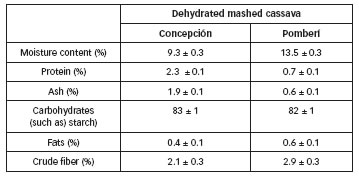
Models
Several different models (11) (12), can describe the variation of density with concentration.

The density values were fitted to lineal, power and exponential models (Eq. (2), (3), (4)).
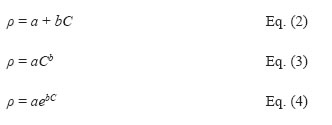
2.2 Preparation of rehydrated mashed
Dehydrated mashed cassava was rehydrated by adding 500, 600, 700 and 800 mL of water at 80º C to 100 g of dried product, in order to obtain diferent mashed concen-trations (200, 167, 143 and 125 g mashed / L water). It was cooked for two minutes and was kept in a thermostatic bath at diferent test temperatures.
Determination of the density
where ρ is the density (kg/m3), C is the concentration (g/L), a and b are constants of the models.
To study the variation of density with temperature and concentration and give a simple equation within the ranges studied, the experimental data have been ftted to a transformed polynomial equation Eq. (5), expressed by (7).
p = a + bT + cC Eq. (5)
where ρ is the density (kg/m3), C is the concentration (g/L), T is the temperature (C), a, b, and c are constants of the models.
The efect of temperature on the density was described by the Arrhenius relationship, Eq. (6) (13).
p = p" exa(-Ea/RT) Eq. (6)
where ρ is the density (kg/m3), ro is a parameter that is considered as the density at infinite temperature (kg/m3), Ea is the activation energy (kJ/mol), R is the molar gas constant (kJ/mol K), and T is temperature (K).
The Ea values were correlated with the concentration (g/L) for the power law Eq. (7) and exponential type Eq. (8) models.
The density was determined by pycnometry (10) and the temperature was controlled by a thermostatic water bath (Schott Gerate, model CT1150 (SCHOTT Instru-ments GmbH, Germany). The determinations were done in triplicate.
The density of the rehydrated mashed was calculated by Eq. 1.
where p is the density (kg/m3), Mpm is the mass of the pycnometer with sample (kg), Mpv is empty pycnometer mass (kg) and V is the volume (m3).

where Ea is the activation energy (kJ/mol), C is the concentration (g/L), a and b are constants of the models.
The goodness of fit of derived models was evaluated by the root mean square error (RMSE) Eq. (9), the mean bias error (MBE) Eq. (10), the mean percentage error (E %) Eq. (11), in addition to R2. These statistics allow for the detection of the diferences between experimental data and the model estimates. These parameters can be calculated as following:
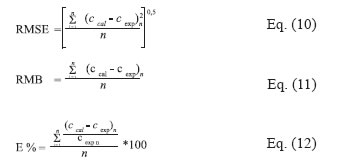
where ccal is the predicted value, cexp is the experimental value and n is the number of data points
A good fit is indicated by small values of RMSE and MBE, R2> 0.85 and E % <10% (14) (15). GraphPad Prism Software 4.0 and Statgraphics Plus for DOS version 7.0 were used in the statistical analysis. All correlations and statistical analyzes were done for a 95% confdence interval.
Results and Discussion
Multifactorial ANOVA indicated that the concentration and temperature significantly influence the density of rehydrated mashed cassava (p < 0.05) of the Conception and Pomberí variety.
As was expected, it shows a decrease in density with an increase in temperature and with a decrease in concentration.
Values of density that have been obtained for rehydrated cassava mashed are comparable with other mashed food or paste with the same trend, such as results obtained by (10) for apple and quince purees, by (13) for banana puree, (6) for pastes of cassava (Manihot esculenta Grantz), sweet potato (Ipomoea batatas L. Lam) and white yam (Diosco-rea rotundata Poir) tubers.
Table 2: Experimental values for density (kg/m3) at different concentration and temperature for the rehydrated mashed cassava, Conception and Pomberí varieties
| Concentration (g/L) | Temperature (°C) | |||||||
| 30 | 40 | 50 | 60 | |||||
| Conception | Pomberí | Conception | Pomberí | Conception | Pomberí | Conception | Pomberí | |
| 200 | 1112.7±0.7a | 1117.3±0.6a | 1107,3±0,3a | 1108.0±0.7a | 1095,3±0,3a | 1098.3±0.3a | 1080,7± 0,9a | 1096.0±0.6a |
| 167 | 1092.7±0.7D | 1098.3±0.6D | 1083,3±0,9D | 1090.7±0.3D | 1066,3± 0,7D | 1082.3±0.3D | 1059,0±0,6D | 1072.0±0.6D |
| 143 | 1070.7 0.7C | 1081.0±0.6C | 1062±1c | 1074.3±0.7C | 1044,7±0,9C | 1063.0±0.6C | 1032,0±0,9C | 1054.0±0.6C |
| 125 | 1055.3±0.9a | 1062.7±0.9a | 1044,7±0,7a | 1050.7±0.3a | 1026,3±0,7a | 1042.7±0.8a | 1012,3±0,9a | 1031.7±0.9a |
Values are average of three replicates ± standard error. * Within a column with different letters are significantly different (p < 0.05)
Table 3: Constants of the linear, potential and exponential models and the goodness of ft for the rehydrated mashed cassava, Conception and Pomberí varieties
| Temperature (°C) | a | b | R2 | Goodness of ft | ||
| RMSE | MBE | E % | ||||
| Model Eq. [2] | ||||||
| 60 | 901±7a | 0.92±0.04a | 0.98 | 3.56 | -0.15 | 0.29 |
| 50 | 913±2a | 0.92±0.01a | 0.99 | 0.88 | 0.03 | 0.08 |
| 40 | 942±4D | 0.83±0.02a | 0.99 | 1.69 | 0.03 | 0.15 |
| 30 | 961±5D | 0.77±0.03a | 0.99 | 2.23 | -0.09 | 0.17 |
| Model Eq. [3] | ||||||
| 60 | 513±11a | 0.141±0.004a | 0.99 | 2.21 | 0.03 | 0.18 |
| 50 | 526±5a | 0.138±0.002a | 1.00 | 0.71 | 0.07 | 0.06 |
| 40 | 574±6D | 0.124±0.002a | 1.00 | 0.30 | 0.004 | 0.02 |
| 30 | 608±8D | 0.114±0.002a | 0.99 | 1.23 | 0.22 | 0.10 |
| Model Eq. [4] | ||||||
| 60 | 911±6a | 0.0009±0.00004a | 0.98 | 3.79 | -0.05 | 0.31 |
| 50 | 923±2a | 0.0009±0.00001aD | 1.00 | 1.12 | 0.01 | 0.10 |
| 40 | 951±4D | 0.0008±0.00002aD | 0.99 | 1.89 | -0.01 | 0.17 |
| 30 | 968±4D | 0.0007±0.00003D | 0.99 | 2.39 | 0.05 | 0.18 |
* Within a column with different letters are significantly different (p < 0.05)
The coefficients and the goodness of fit of the three models indicated that all of them adequately describe the variability of density with the concentration. However, statistical analysis showed that potential model seems to describe better the efect of the concentration on the density in comparison with linear and exponential model. The higher is the values of R2 average for all temperatures and the lower is the values of E %, MBE and RMSE, the better will be the goodness of ft. A multiple regression analysis on the density-concentration data showed that the three models statistically ftted, and they could be proposed to evaluate the density of rehydrated mashed cassava for the interval of concentrations studied.
For all models and both varieties, the parameter ''a'' decreased with increasing temperature for all studied concentrations. Parameter ''b'' decreased with decreasing temperatures, but the associated changes were very small.
Influence of combined effect of temperature and concentration on the density of rehydrated mashed cassava
Different models were proposed by various authors to represent the combined effect of temperature and concentration on the density. The model that ftted most appropriately to the experimental values was a polynomial equation, where the density varies linearly with temperature and with concentration for both varieties. Table 4 shows the values of the obtained constants and summary of the statistical analysis.
The density decreases with temperature with a coeficient of -1.27 and -0.89 and increased with concentration with a coefficient of 0.85 and 0.75 for Conception and Pomberí varieties, respectively.
Table 4: The combined effect of temperature and concentration on the density of rehydrated mashed cassava
| Model Eq. [5] | a | b | c | R2 | Goodness of ft | ||
| RMSE | MBE | E % | |||||
| Conception | 986±4 | -1.27±0.04 | 0.85±0.02 | 0.99 | 3.41 | -0.05 | 0.24 |
| Pomberí | 996±4 | -0.89±0.05 | 0.75±0.02 | 0.97 | 3.89 | 0.0005 | 0.33 |
The density of cassava starch powder decreased with increasing temperature with a coeficient of -0.462, but increased with increasing concentration with a coeficient of 2.116, in the temperature range (30-50° C) and concen-tration (20-50% w/w) (7).
Influence of temperature on the density of rehydrated mashed cassava
Density of rehydrated mashed cassava of both varieties, Conception and Pomberí, at diferent concentrations has also found to be a function of temperature. It decreases considerably with increasing temperature. The efect of temperature on the density follows an Arrhenius-type relationship with R2 valúes greater than 0.95 (Table 5).
Table 5: Parameters of the Arrhenius-type model for Conception and Pomberí varletles
| Concentration (g/U | jo | Ea(kJ.moM) | R2 | Goodness of ft | ||
| RMSE | MBE | E % | ||||
| Conception variety | ||||||
| 200 | 806±19a | 0.82±0.04a | 0.95 | 2.7 | -0.05 | 0.25 |
| 167 | 763±14D | 0.91±0.03D | 0.97 | 2.03 | -0.08 | 0.17 |
| 143 | 704±16c | 1.06±0.05c | 0.97 | 2.27 | 0.08 | 0.18 |
| 125 | 660±13a | 1.19±0.03a | 0.98 | 1.96 | 0.2 | 0.17 |
| Pomberí variety | ||||||
| 200 | 893±14a | 0.56±0.02a | 0.95 | 1.73 | -0.04 | 0.14 |
| 167 | 844±9aB | 0.66±0.02D | 0.98 | 1.06 | 0.04 | 0.1 |
| 143 | 807±9DC | 0.74±0.03c | 0.99 | 1.04 | 0.03 | 0.08 |
| 125 | 771±9D | 0.81±0.02c | 0.99 | 0.78 | 0.01 | 0.07 |
Within a column with different letters are significantly different (p < 0.05)
Activation energy values (Ea) ranged from 0.56 to 0.81 for Conception variety and 0.82 to 1.19 kJ/mol for Pomberí variety. Mashed cassava of Conception variety showed the highest activation energy values. Density was most afected by the temperature with decreasing concentration. The efect of concentration on activation energy is displayed in Fig. 1 for both, Conception and Pomberí varieties. Results showed that the activation energy decreased when concentration increased.
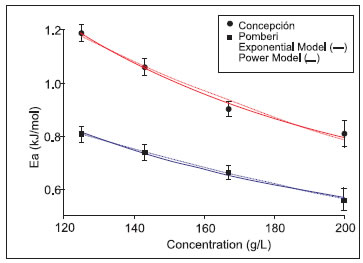
Figure 1: Activation energy-concentration plot for the rehydrated mashed cassava for Conception and Pomberí varieties.
Therefore, the density variation is more sensitive to tem-perature at low concentration, i.e., the less the concentration, the more the temperature sensitivity was. The variation of activation energy with concentration was modeled by using both exponential and power models. The linearized forms of these two equations were used to determine the model constants (Table 6). Power model was found to be a better ft for Conception variety and exponential model was found to be a better ft for Pomberí variety.
All models had a good ft to the experimental data as shown by the values of R2, RMSE, MBE and the percentage error of the table6. Results in this study indicated that the density of the rehydrated mashed cassava followed an Arrhenius type variation with temperature, and the change of experimental activation energy data with the concentration could be fitted to a power model for Conception variety and exponential model for Pomberí variety. The values of activation energy of other tubers were not found in literature.
Table 6: Infuence of concentration on activation energy
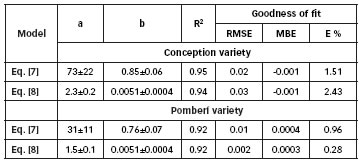
Conclusion
Density of rehydrated mashed cassava for Conception and Pomberí varieties prepared in concentrations of 200, 167, 143 and 125 g/L were measured at 30, 40, 50 and 60º C. Statistical analysis indicated that temperatures and concentrations significantly (p < 0.05) afected density. The concentration infuences in 74 and 82% on the variation of the density, for variety Concepcion and Pomberí, respecti-vely, and the temperature infuences to a lesser degree on the total variation, in a value of 26% and 16% for variety Concepcion and Pomberí, respectively.
Density -concentration relationship was expressed by lineal, power and exponential models with excellent ft, and density- concentration and temperature combined efect relationship could be related by a polynomial equa-tion. The variation of density with temperature at constant concentration followed an Arrhenius-type model, and the obtained activation energy has been related to concentra-tion by power and exponential models for both varieties.
The efect of temperature and concentration on density can be described by equations that could be useful for preliminary equipment design, and process design and have direct applications fuid fow and heat transfer.
References
1. Núñes-Santiago, M. C.; Bello-Pérez, L. A. and Tecante, A. Swelling-solubility characteristics, granule size distribu-tion and rheological behavior of banana (Musa paradisiaca) starch. Carbohydrate Polymers. 56(1): p. 65-75. 2004. [ Links ]
2. Evans, I. D. and Haisman, D. R. Rheological of gelatinized starch suspensions. Journal of Texture Saudíes. 28: p. 253-257. 1997. [ Links ]
3. Godfrey, T. and West, S. Industrial enzymology. MacMillan, London, 1996; p. 341-351. [ Links ]
4. Lii, C. Y. ; Tsai, M. L. and Tseng, K. H. Efect of amylose content of the rheological properties of rice starch. Cereal Chemistry. 73: p. 415-420. 1996. [ Links ]
5. Pongsawatmanit, R.; Temsiripong, T.; Ikeda, S. and Nishinari, K. Infuence of tamarind seed xyloglucan on rheological properties and thermal stability of tapioca starch. Jour-nal of Food Engineering. 77(1): p. 41-50. 2006. [ Links ]
6. Carbohydrate: Iwuoha, C. I. and Nwakanma, M. I. Density and viscosity of cold four pastes of cassava (Manihot escu-lenta Grantz), sweet potato (Ipomoea batatas L. Lam) and white yam (Dioscorea rotundata Poir) tubers as affected by concentration and particle size. 37: p. 97-101. 1998. [ Links ]
7. Songklanakarin Journal of Science and Technology: Cansee, S.; Watyotha, C.; Thivavarnvongs, T.; Uriyapongson, J. and Varith, J. Efects of temperature and concentration on thermal properties of cassava starch solutions. 30(3): p. 405-411. 2008. [ Links ]
8. Food Chemistry: Rondán-Sanabria, G. G. and Finardi-Filho, F. Physical-chemical and functional properties of maca root starch (Lepidium meyenii Walpers). 114: p. 492-498. 2009. [ Links ]
9. Food Technology: Saravacos, G. D. and Kostaropoulos, A. E. Transport properties in processing of fruits and vegetables. 49(9) : p. 99-100, 102-105. 1995. [ Links ]
10. Journal of Food Engineering: Ramos, A. M.; Ibarz, A. Density of juice and fruit puree as a function of soluble solids content and temperature. 35: p. 57-63. 1998. [ Links ]
11. Food Research International: Marcotte, M.; Taherian Hoshahilia, R. and Ramaswamyb, H.S. Rheological properties of selected hydrocolloids as a function of concentration and temperature. 34: p. 695-703. 2001. [ Links ]
12. Journal of Food Engineering: Kaya, A. and Belibagli, K. B. Rheology of solid Gaziantep Pekmez. 54: p. 221-226. 2002. [ Links ]
13. Journal of Food Engineering: Tsen, J. H. and King, V. A. E. Density of banana puree as a function of soluble solids concentration and temperature. 55: p. 305-308. 2002. [ Links ]
14. Journal of Food Engineering: Park, K. J.; Vohnikova, Z. and Brod, F. P. R. Evaluation of drying parameters and desorption isotherms of garden mint leaves (Mentha crispa L.). 51: p. 193-199. 2002.
15. Ciência e Tecnologia de Alimentos: Vega-Gálvez, A.; Lara-Arave-na, E. and Lemus-Mondaca, R. Isotermas de adsorción de harina de maíz. 26: p. 821-827. 2006.
16. Official Methods of Analysis (16th ed.). AOAC. Washington DC, USA. Association of Oficial Analytical Chemists. 1995.
Recibido: 27/02/2018. Aprobado: 25/09/2018.














